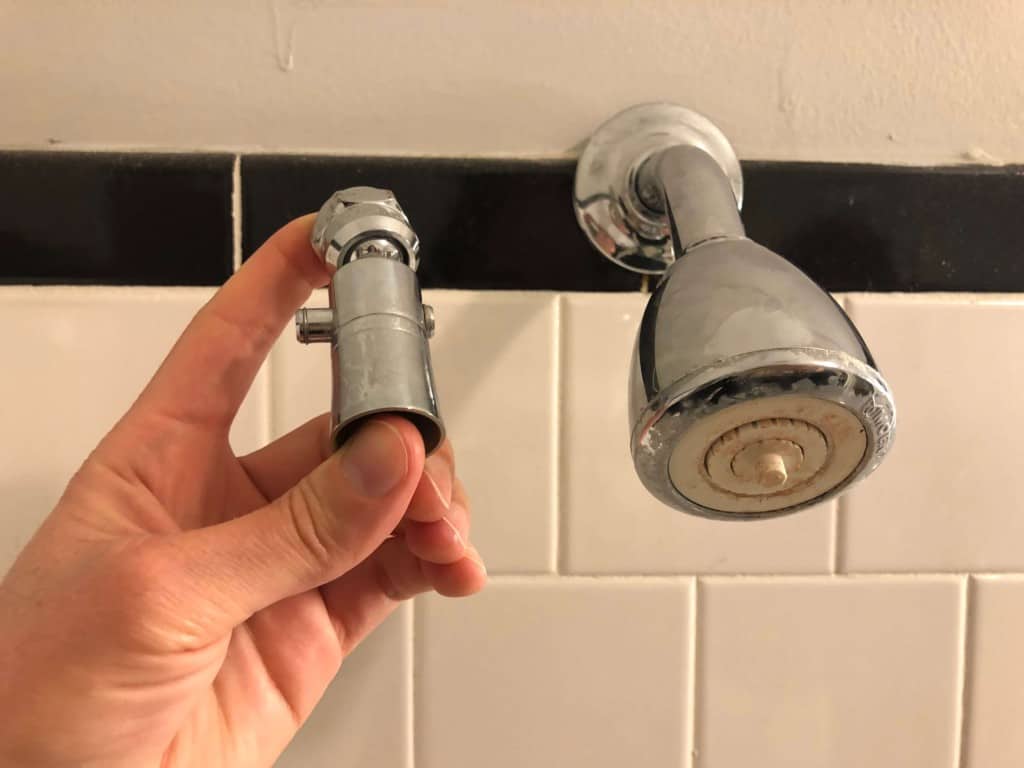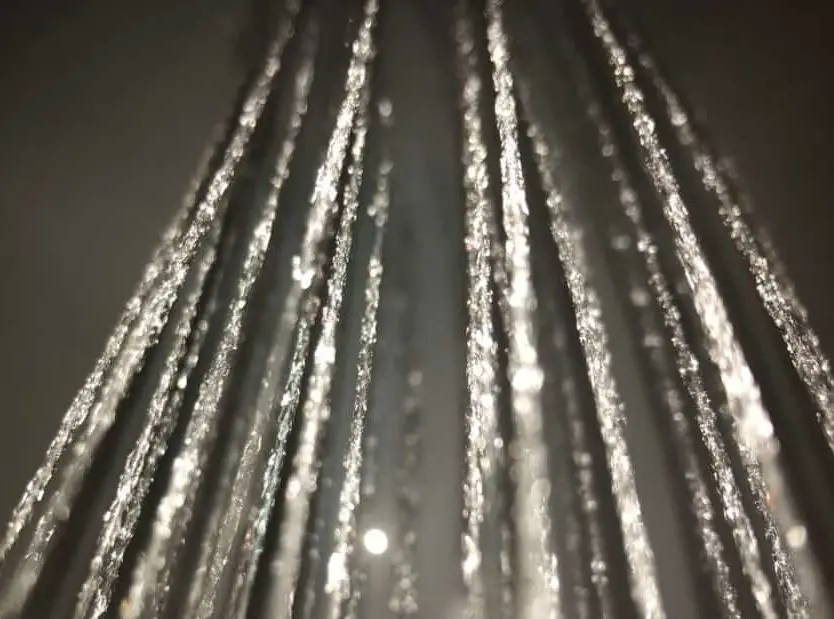
A lot of people have problems with low pressure from their shower, which can make showering difficult or even downright unpleasant. If you’re looking for a quick fix, you might be asking yourself: will a smaller showerhead increase the water pressure?
Using a smaller showerhead will not guarantee an increase in the pressure of your shower. The pressure that comes through a showerhead has more to do with the design of the showerhead, and less to do with the actual size of the showerhead. The water pressure of the building’s water line is also a factor.
Let’s not stop there—in the following few sections, we’ll dig into more details on the following topics:
Table of Contents
Will A Smaller Showerhead Increase Water Pressure?
As mentioned above, using a smaller showerhead does not mean you will automatically experience an increase in the pressure of your shower.
Showerheads are manufactured in many different shapes and sizes, and with today’s technology, you can easily find both small and large showerheads designed to deliver a high-pressure shower.
Something that you might find surprising is that in the world of plumbing, shower pressure and water pressure generally aren’t equivalent.
Water pressure typically refers to the strength with which water gets from your water supply to your home. This is measured in “psi” – pounds per square inch.
On the other hand, the thing most people ultimately care about when they hop in the shower is the velocity at which the water comes out of their showerhead.
When a showerhead is advertised to be a “high-pressure” showerhead, it’s meant to give you a higher velocity in the shower, which can also help to compensate for the low water pressure that some homes have.
If you suspect that there’s a larger underlying problem causing your low water pressure, and it’s not just your showerhead, here are two ways in which you can test your water pressure.
How To Test Your Water Pressure

So you think you have low water pressure, but how can you be sure that something’s wrong? Here are two ways to test the water pressure of your home/building, to determine if it’s too low:
Test Water Pressure Using A Pressure Gauge
You can purchase a water pressure gauge from your local hardware store or online. It’ll be most convenient to get one with a female hose thread.
1. Turn off all faucets inside and outside of your home that use running water
For example, your washing machine, dishwasher, shower, refrigerator ice makers, sprinkler system, etc.
Also, make sure water is not being used while you are testing the pressure (everyone can flush the toilet later!). Keep the water supply on.
2. Find the spigot inside or outside of your home that’s closest to your main water supply, which should be close to your water meter.
This might be in a basement, garage, or outside. If this is not an option, you can also attach it to a faucet on the first floor of your home. However, since the water pressure changes as it moves through the pipes, you might not get an accurate reading.
3. Make sure the spigot is completely off, and connect your water pressure gauge to the threaded spigot.
You can do this by hand. There should be threads on both the valve and the gauge that allows you to easily connect them by twisting clockwise.
4. Turn the handle or lever by the spigot all the way on to start the flow of water.
Make sure there’s no water leaking. If you see a leak, turn off the water using the handle, and adjust the water pressure gauge until it doesn’t leak with the spigot on.
5. Look at the gauge to read your pressure
Once you have the spigot on and there are no leaks. The needle should point to the number representing the psi. Make a note of it. You’ll want to make sure it’s above 40 psi or else you may have low water pressure.
6. Fully turn off the water to your spigot
Turn off the water and remove your gauge by unscrewing it from the spigot.
If you don’t have a pressure gauge, no worries, next we’ll cover how you can test your water pressure without one.
Test Water Pressure Without A Pressure Gauge
If you can’t get a hold of a water pressure gauge, do not fear. You can also test your water pressure using a gallon bucket and timer.
You should be able to find a timer on your smartphone if you have it handy—I typically use it when baking or cooking multiple dishes at a time!
1. Same as before, turn off all faucets inside and outside of your home that use running water
Make sure water is not being used while you are testing the pressure. You will want to keep the water supply on.
2. Find the spigot that’s closest to your main water supply, and make sure it’s turned off.
Again, since water pressure changes as it moves through your pipes, you will want to test as close to your water supply as possible.
3. Place your bucket directly underneath of the spigot
Once you have located it. Be sure that your bucket holds exactly one gallon! That’s 3.785 liters or 4 quarts.
4. Turn on the spigot using the nearby handle, and track the time it takes for the bucket to fill.
This is where you might need a second person to help with the timer as you turn on the spigot.
5. Turn off the water to your spigot once the bucket is filled.
You can now dump out your water. Hopefully there are some plants and trees around to benefit from that water!
6. Divide 60 by the number of seconds it took to fill the bucket.
For example, if it took 10 seconds for the one-gallon bucket to be completely filled, you’ll calculate 60/10= 6. This is the flow rate by minute. In this example, you have 6 gallons/minute.
If you have a water flow rate of under 6 gallons per minute, that means you might have low water pressure.
Tips to Increase Your Shower Pressure

Whether the problem stems from your shower head itself or the water pressure of your building, here are a few tips you can try to alleviate the problem:
Tip #1: Clean Your Showerhead
It could just be that your showerhead is dirty and clogged with mineral deposits. With a few common household ingredients, you can clean your showerhead.
Tip #2: Replace Your Showerhead
If cleaning didn’t do it, you can replace your showerhead with a new one that is designed to increase the shower velocity in low water pressure homes.
Tip #3: Remove showerhead flow restrictor
Most showerheads have flow restrictors that control how much water flows out of them, and you can remove those restrictors. However, keep in mind that there are regulations on water use, and removing the restrictor can also increase your water bill.
If you’re curious about the rules on water consumption, the Energy Policy Act of 1992 requires showerheads manufactured after 1993 to have a maximum water usage of 2.5 gpm (gallons per minute). And some States have even stricter requirements.
Tip #4: Re-adjust showerhead attachment
If you see a leak near your showerhead, simply unscrew your showerhead using your hands (or a wrench if needed) and re-adjust so that it seals. If there’s not any applied already, you can also add Teflon tape around the threads of your shower arm to create a better seal.
Tip #5: Shower at odd times
The overall water usage in your home/apartment will affect the water pressure that reaches your shower. As a result, you may be able to increase the water pressure you feel, simply by showering at unusual times.
Tip #6: Get a plumber involved
Sometimes, you’ll just need to get a professional involved. For serious plumbing problems, you may want to call a plumber to…
- Check the main water supply
- Check pipes for mineral deposits
- Identify any problems you haven’t even thought of
Related Questions
Can you change the showerhead in a rental?
You can usually change the showerhead in a rental, as long as there are no clauses in your lease regarding plumbing and fixtures. It would be wise to double-check with your landlord and get it in writing. If you do end up changing the showerhead, be sure to keep the old one so you can put it back on later. For more details, check out our other blog post here.
What should the water pressure in my home be?
The water pressure in your home should fall between 40 and 80 psi (pounds per square inch). If your water pressure is below 40 psi or above 80 psi, it means that your water pressure is either too low or too high.

